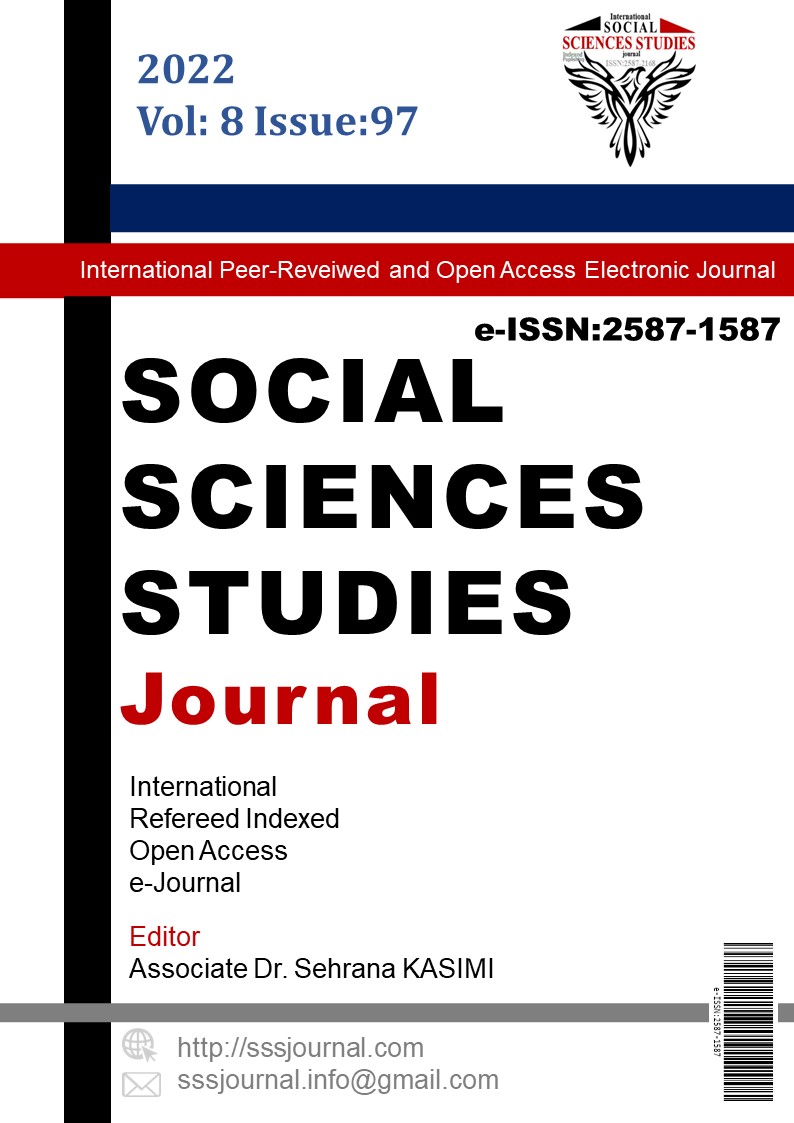Tarihi Yapılarda İç Mekan Tasarımına Yönelik Bir Öğretim Yaklaşımı Önerisi Ve Tasarım Çıktılarının Değerlendirilmesi
Author :
Abstract
İç mekan tasarımı, yapı ile mekan, mekân ile kullanıcı arasındaki doğru bağı kurmaya yardımcı bir enstrümandır. İç mekan tasarımı bir yapının kapalı ve acık tüm mekanların amacına uygun nasıl daha verimli ve işlevsel kullanılacağına yönelik çözüm önerileri sunar. Bu öneriler hem cağımız iç mekan tasarım düzeni için geçerli olabiliyorken, yasadığımız zaman diliminden yüzyıllar önce yapılmış tarihi yapılar için de geçerli olabilir. Bu çalışma, 2019-2020 Bahar Eğitim-Öğretim döneminde ERÜ Mimarlık bölümünde seçmeli ders olarak tanımlanmış “MİM S100 Tarihi Yapılarda İç Mekan Tasarımı” isimli ders kapsamında yürütülmüştür ve ders kapsamındaki stüdyo çalışmalarının, yöntem ve tecrübelerin değerlendirilmesi içermektedir. Hedefe yönelik uygulanan yöntem, uygulama sırasında edilen tecrübe ile beraber yürütülen ders işleme süreci, öğrencilerin mekan ve kullanıcı bağını daha net olarak algılamaları sağlanmıştır. Ders kapsamında hazırlanan tasarım paftaları ile öğrenciler, bir iç mekanı nasıl analiz edeceği ve işlevi göz önünde bulundurularak nasıl iyi bir tasarım ortaya konacağını dört ana adımda deneyimlemiştir. Bu dört ana adımın oluşturduğu süreç, öğrenciler yaratıcılığını desteklemiş ve beslemiştir. Sonuç olarak bu derste teorik içeriklere nazaran daha gerçekçi ve nitelikli iç mekan tasarımına yönelik çıktı önerileri elde edilmiştir.
Keywords
Abstract
Interior design is a tool that helps to establish the right connection between building and space, space and user. Interior design offers solutions for how to use the interior spaces of a building more efficiently and functionally in accordance with its purpose. These recommendations are valid for interior design of buildings built in our era. It can also apply to the interior design of historical buildings built centuries ago. This study was carried out within the scope of the course named "MİM S100 Interior Design in Historical Buildings" at Erciyes University, Department of Architecture in the 2019-2020 Spring Academic Year. This study includes the evaluation of studio work, methods, and experiences in the Interior Design of Historic Buildings course. The method and experience applied towards the target enabled the students to perceive the space and user connection more clearly. With the design sheets prepared within the scope of the course, the students learned how to analyze an interior. In addition, they have experienced in four main steps how to create a good interior design, taking into account the function. The design process, which consists of these four main steps, supported and nurtured the creativity of the students. As a result, in this course, a more realistic and qualified interior design has been achieved compared to the theoretical content.
Keywords
- Andaç Güzel, T. (2019). “İşlevi Değiştirilerek Tüketim Mekanlarına Dönüştürülen Tarihi Yapılarda Mekanın
- Andaç Güzel, T. (2019). “İşlevi Değiştirilerek Tüketim Mekanlarına Dönüştürülen Tarihi Yapılarda MekanınTüketimi ve Mekan-Kullanıcı Etkileşimi Üzerine Bir Araştırma”, International Social Sciences Studies Journal, 5(36):2981-2988
- Aytaç, Ö. (2007). Kent Mekânlarının Sosyo-Kültürel Coğrafyası. Fırat Üniversitesi Sosyal Bilimler Dergisi, 17(2), 199-226.
- Bilgin, N. (2011). Eşya ve insan. Gündoğan Yayınları. İstanbul.
- Bloszies, C. (2013). Old Buildings New Designs: Architectural Transformations. Princeton Architectural Press.
- Buyruk, L. (2011). Butik Otel Çalışanlarının Butik Otel Kavram ve Hizmetlerini Algılamaları Üzerine Bir Araştırma Kapadokya Örneği. Presented at the 12. Ulusal Turizm Kongresi, Akçakoca-Düzce.
- Ching, F.D. K. (2006) İç Mekan Tasarımı: Resimli. Yapı-Endüstri Merkezi yayınları
- Coles, J., House, N. (2012). İç Mimarlığın Temelleri. Literatür.
- Coates, M., Brooker, G., Stone. (2011). Görsel İç Mimarlık Sözlüğü, İstanbul: Literatür Yayınları.Eco, U., (2003). Function and Sign: The Semiotics of Architecture. Londra
- Grimley, C., & Love, M. (2007). Color, space, and style: all the details interior designers need to know but can never find. Rockport Publishers.
- Kahveci, H., & Göker, P. (2020). Kent Mobilyaları Tasarım Dersi Stüdyo Çalışması; Üst Örtü-Oturma Birimi ve Piknik Donatısı Tasarımı. Bartın Orman Fakültesi Dergisi, 22(3), 693-707.
- Kayseri Büyükşehir Belediyesi, (2022a). “Sahabiye Medresesi ve Çeşmesi”, https://www.kayseri.bel.tr/kesfet- listeleme/sahabiye-medresesi-ve-cesmesi, (Erişim: 20.01.2022)
- Kayseri Büyükşehir Belediyesi, (2022b). “Hunat Hatun Külliyesi”, https://www.kayseri.bel.tr/kesfet- listeleme/hunat-hatun-kulliyesi(Erişim: 20.01.2022)
- Kayseri Valiliği. (2022). “Kayseri Tarihi” http://www.kayseri.gov.tr/kayseri-tarihii, (Erişim: 19.01.2022).
- Türkiye Kültür Portalı (2022). “Sahabiye Medresesi-Kayseri” https://www.kulturportali.gov.tr/turkiye/kayseri/gezilecekyer/sahabiye-medresesi, (Erişim: 20.01.2022).
- Lindenau, A. (2020). The Art and Science of Color in Holistic Interior Design: A Crash Course, Independently Islam Ansiklopedisi. (2022a). “Kayseri”, https://islamansiklopedisi.org.tr/kayseri, (Erişim: 19.01.2022)
- Islam Ansiklopedisi. (2022b). “Medrese”, https://islamansiklopedisi.org.tr/medrese#4-mimari,(Erişim: 19.01.2022)Islam Ansiklopedisi. (2022c). Huand Hatun Külliyesi,https://islamansiklopedisi.org.tr/huand-hatun-kulliyesi, (Erişim: 19.01.2022)
- Pekol, B. (2010). İstanbul'da Yeni İşlevlerle Kullanılan Tarihi Yapıların Üslup Sorunsalı. Doktora Tezi, İTÜ Fen Bilimleri Enstitüsü, İstanbul.
- Postell, J. (2012). Furniture design. John Wiley & Sons.
- Cambridge Dictionary (2022). Coffee shop, https://dictionary.cambridge.org/tr/s%C3%B6zl%C3% BCk/ingilizce/coffee-shop, (Erişim: 05.02.2022).
- Merriam-Webster (2022). Style, https://www.merriam-webster.com/dictionary/style, (Erişim: 05.02.2022).
- Müezzinoğlu, M. K. , Noraslı, M. & Sungur, M. (2020). Taşınmaz Bir Kültür Varlığının Yenidenİşlevlendirilmesine Yönelik Sistematik Analiz . The Journal of International Lingual Social and Educational Sciences , 6 (1) , 113-123 . DOI: 10.34137/jilses.572504
- Morris, B. (2010). Fashion illustrator. Laurence King Publishing.
- Turan, O. (1980). Selçuklular Tarihi ve Türk-İslam Medeniyeti. İstanbul.





